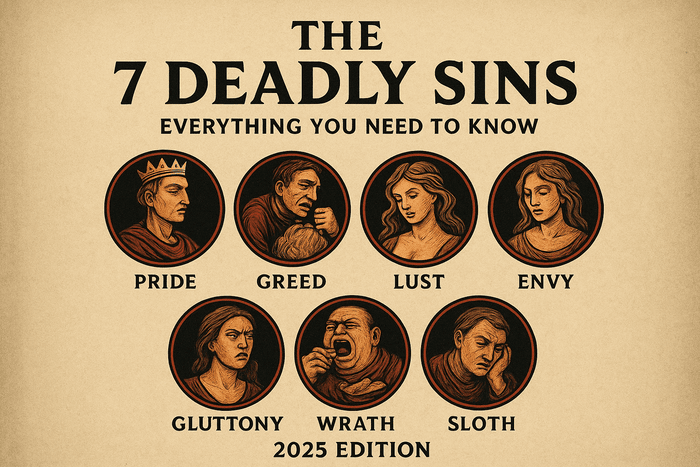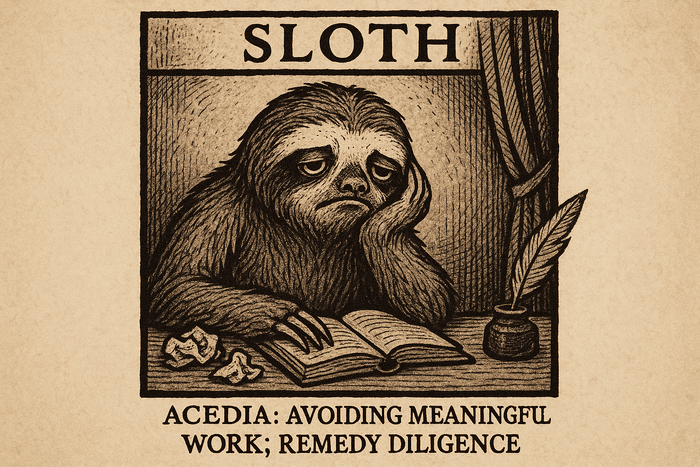
India’s economy has transformed dramatically over the last decade, and the demand for top business coach India services has grown...
The 7 Deadly Sins—Pride, Greed (Avarice), Lust, Envy, Gluttony, Wrath, and Sloth—are classic “capital vices”: root-level habits that spawn other harmful behaviors. They aren’t one-off mistakes but patterns that bend desire, attention, and action away from what’s good for you and others. Their antidotes are the “contrary virtues”: Humility, Charity/Generosity, Chastity, Kindness, Temperance, Patience, and Diligence. This 2025 edition adds clear definitions, modern examples (including at work), and small practices to retrain your habits.

Short definition: The 7 Deadly Sins are a traditional catalog of capital vices—“capital” from caput (head)—because they lead to many other sins. These are habit patterns rather than single slips: entrenched grooves of thinking and wanting that, left unchecked, degrade character, relationships, and community.
The list:
Key idea: The opposite of each vice is not shame; it’s practice—concrete behaviors that build the contrary virtue over time. You don’t merely “avoid vice”; you train desire toward the good.
Though born in a Christian context, the seven read like pre‑modern moral psychology. Modern terms map surprisingly well: ego defenses (pride), scarcity mindset (greed), compulsion (lust), social comparison (envy), overconsumption (gluttony), dysregulated anger (wrath), and meaning fatigue/avoidance (sloth).
This edition is structured for clarity and action:
Below, you’ll find each sin in the same pattern: essence → modern lens → at work → contrary virtue → micro‑practices. Use the micro‑practices like reps at the gym: small, repeatable actions that slowly retrain attention and desire.
Essence (plain): An inflated, distorted self‑regard that resists reality checks. Pride centers the self so completely that others become mirrors or obstacles.
Modern lens: Ego defensiveness, status signaling, “I’m the exception,” inability to receive feedback, reputation over reality.
At work: Hoarding credit, talking over others, dismissing junior voices, never asking clarifying questions, interpreting critique as attack.
Contrary virtue: Humility—not self‑loathing, but accurate self‑assessment + openness to learn.
Micro‑practices:
Mini‑script:
“Here’s what I was aiming for, here’s where it landed, and here’s how I’ll adjust. Anything I’m not seeing yet?”
Essence: Excessive grasping—money, power, status, attention. It is scarcity‑mindset in action: never enough.
Modern lens: Over‑optimizing compensation at the expense of relationships, turf wars, “data hoarding,” networking only upward.
At work: Withholding information, designing incentives that reward solo success and punish collaboration, “my team vs. your team” politics.
Contrary virtue: Charity/Generosity—sharing resources, credit, and opportunities; designing systems that reward contribution to the whole.
Micro‑practices:
Try this reflection:
“If I got everything I’m chasing, what would I be afraid to lose next?” (Greed moves the goalposts; generosity unmasks that drift.)
Essence: Disordered desire—treating persons (or even achievements) as objects for self‑stimulation.
Modern lens: Compulsive novelty seeking; addiction to the high of the next win; boundary violations; reducing people to utility.
At work: Hustle addiction, achievement‑chasing without recovery, “performative networking,” blurred lines in power dynamics.
Contrary virtue: Chastity—rightly ordered desire and self‑mastery. It’s not prudishness; it’s dignity and consent elevated above impulse.
Micro‑practices:
Checkpoint:
“Am I loving people and using things—or using people and loving things?”
Essence: Pain at another’s good—if they have it, I lose.
Modern lens: Doom‑scrolling others’ highlight reels, resentment at peers’ promotions, subtle undermining.
At work: “Left‑handed compliments,” low‑key sabotage, withholding praise, undercutting in meetings.
Contrary virtue: Kindness/Gratitude—the ability to celebrate others’ good and learn from it.
Micro‑practices:
Phrase to use:
“Seeing you do X clarified what I want to learn next—could I ask you 2–3 questions about your path?”
Essence: Excess—traditionally food/drink; today also inputs: content, meetings, tabs, feeds.
Modern lens: Information binging, calendar bloat, endless grazing on Slack/WhatsApp, inability to sit with an unfilled moment.
At work: Too many meetings, no focus time, “just one more link” spirals, compulsive notifications.
Contrary virtue: Temperance—right measure; designing limits that keep joy and clarity intact.
Micro‑practices:
Tiny test:
Can you leave your phone in another room for 45 minutes without anxiety? If not, you’ve found your next practice.
Essence: Disordered anger—not the presence of anger (which can be signal), but unregulated expression or simmering resentment.
Modern lens: Fight‑or‑flight hair‑trigger, sarcastic venting, revenge tasks, ghosting.
At work: Public outbursts, hostile emails, stonewalling, “punishment by process” (making things difficult for someone you’re angry at).
Contrary virtue: Patience—regulation first; then timely, truthful response.
Micro‑practices:
Boundary check:
Anger’s job is to name a boundary—not to scorch the earth. Do both: name, then repair if needed.
Essence: Not laziness; avoidance of the good that’s yours to do. Acedia feels like listlessness, meaning‑fatigue, or restless procrastination.
Modern lens: Doom‑scrolling while “busy,” over‑planning instead of starting, drifting from what matters because it’s emotionally heavy.
At work: Procrastinating “the one meaningful task,” living in low‑stakes busywork, never committing because committing risks failure.
Contrary virtue: Diligence—steady, value‑aligned effort.
Micro‑practices:
Reframe:
Don’t wait to feel motivated; act small, let motivation catch up.
|
Sin |
Essence (1‑liner) |
Contrary Virtue |
2–3 Practices You Can Start This Week |
|
Pride |
Inflated, defensive self‑regard |
Humility |
Steel‑man one critique; ask one genuine learning question per meeting; share credit in writing. |
|
Avarice |
Excessive grasping (money, power, attention) |
Charity/Generosity |
Monthly give‑list; share dashboards/docs by default; add a team‑outcome KPI. |
|
Lust |
Disordered desire; using people or wins as objects |
Chastity |
Input‑based goals; schedule recovery; explicit consent and bright‑line policies. |
|
Envy |
Pain at another’s good |
Kindness/Gratitude |
Envy log → learning plan; weekly praise note; spotlight someone else monthly. |
|
Gluttony |
Excess input/consumption |
Temperance |
90‑min deep‑work block; meeting diet; batch email + archive. |
|
Wrath |
Unregulated anger |
Patience |
90‑second physiological reset; SBI feedback; repair script. |
|
Sloth |
Avoiding one’s proper work |
Diligence |
10‑minute bridge; energy‑based planning; weekly task pruning. |
Try these:
Use the following questions as a weekly review. Mark any “Yes” as a potential focus area:
Pick one “Yes,” pair it with two micro‑practices from above, and run a 30‑day experiment.
Day 1: Pick your focus sin (the pattern you trip on most). Write why it matters to you in 3 lines.
Day 2: Choose two micro‑practices. Block them on your calendar (yes, literally).
Day 3: Tell an accountability buddy the specific habit you’re testing.
Day 4: Add one bright‑line (e.g., phone out of room for first 45 minutes of deep work).
Day 5: Reflect: What got easier? What’s still sticky? Adjust one variable.
Day 6: Rest and review—virtue builds with recovery.
Day 7: Celebrate a small win; write one sentence you’re proud of (humility isn’t hiding progress).
Repeat weekly for a month. Expect small, compounding gains—not fireworks.
Case 1 — Pride at the stand‑up:
A senior PM dismisses a junior engineer’s risk call‑out. Two weeks later, the risk becomes a real blocker. Practice: Start each stand‑up with “unknowns check.” The PM also adds a learning question to each review: “What am I missing?” That lowers ego defensiveness and surfaces reality faster.
Case 2 — Greed in incentive design:
A sales team’s comp plan rewards individual bookings only, so reps hoard leads. Pipeline volatility rises. Practice: Add a team quota component and a monthly “give‑list” ritual (intros/resources). Sharing becomes rational, not just noble.
Case 3 — Gluttony + Sloth loop:
A content lead has 22 tabs open and “research” morphs into avoidance. Practice: Close everything, set a 10‑minute bridge, and start a draft. Run a 90‑minute deep‑work sprint. The first paragraph gets written—momentum begins.
Case 4 — Wrath repair:
A manager fires off a snarky email late at night. Morning regret. Practice: Repair script: “Here’s what I did; here’s the impact; here’s my next step. I apologize.” The relationship recovers, and they adopt a policy: no feedback emails after 7 p.m.

The Seven are not about being perfect; they’re about noticing patterns early and practicing better ones. If you only take one thing from this guide, let it be this: pick one virtue and train it like a skill for 30 days. Small, consistent reps beat dramatic intentions every time.
If you want a printable checklist, a mini self‑assessment, or a team workshop outline, say the word—I can spin those up to match this guide’s structure.

India’s economy has transformed dramatically over the last decade, and the demand for top business coach India services has grown...

When searching for a certified life coach program price, it’s natural to start by comparing tuition fees. Aspiring coaches want...

Neuro-Linguistic Programming (NLP) is experiencing a resurgence in India. Social media, workshops and high-energy seminars promise instant breakthroughs by rewiring...

Many professionals pursue the title of Certified Organizational Development Coach with the expectation that a credential alone will open corporate...

Some providers offer to fast-track you to PCC status through purely online modules for a fraction of the cost of...

Executive coaching has evolved from a niche service for struggling leaders into a strategic investment for organisations aiming to build...

When prospective coaches research training options, cost is often the first number they look for. A quick internet search produces...

Deciding to invest in life coach training programmes can be a transformative milestone in your personal and professional journey. In...

Choosing the right online life coaching courses can be one of the most transformative decisions you ever make.